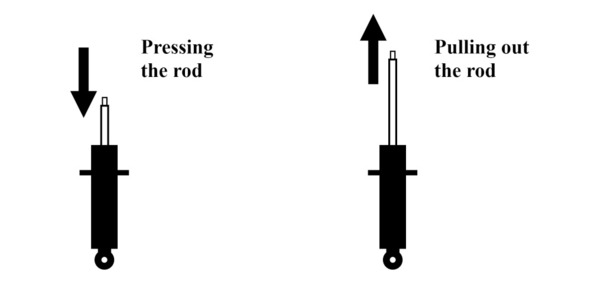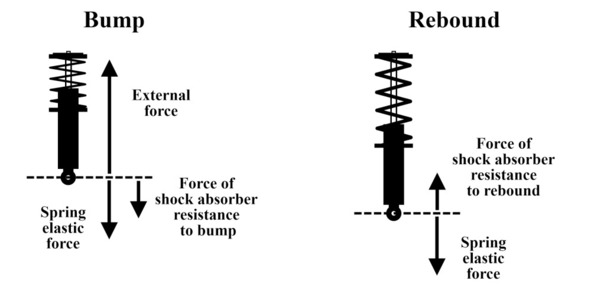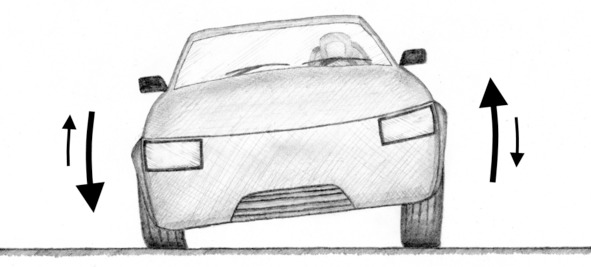
Полная версия
Extreme and defensive driving. 2nd expanded edition
• if machine has received a large moment of rotation and drift angle increases rapidly, you should not wait for drift angle reaches 140—160 degrees and lock the front wheels to slow down the rotation; but after stopping the increase of the drift, drift angle should hit into range of approximately 140—160 degrees to complete turnaround.
Exercise 1. Provoke a drift with an amplitude of more than 90 degrees on a front-wheel-drive car. Create skid of the front wheels in the first or second gear to get out of the drift.
Exercise 2. Provoke a drift with angle greater than 90 degrees on a rear-wheel-drive car. To increase drift angle, cause the rear wheels to skid in the first or second gear.
Exercise 3. Provoke a slide angle of 140—160 degrees. Return car, using the brake system to lock the front wheels. As soon as car starts to turn around, the brake pedal may be released.
Exercise 4. Provoke a sliding angle of 140—160 degrees. Turn the steer in direction of increasing drift to turn car around. Straighten the steer before completing turnaround.
Which of the ways to get out of drift, used in exercises 3 and 4, allowed you to perform turnaround faster?
Exercise 5. Accelerate car in reverse. Perform a small turn of the steer to bend trajectory of movement. Then perform turnaround by locking the front wheels.
Rocking, rhythmic drift
In the chapter “Drift: causes of origin and methods of fighting” it was shown, that when passing an S-like corner drift can occur when moving to the second half of the corner, which is related to the rocking of car body. Let us understand, what causes occurrence of drift and learn how to fight with rhythmic drift.
When passing a corner, centrifugal force causes the center of mass of car to move to the wheels, which are located on the outside of a corner. Suspension springs of the wheels, which are loaded with car’s mass, are compressed and store mechanical energy. When changing the direction of corner the energy is released, the springs are discharged and push the center of mass in the opposite direction, and other two springs begin to shrink. Definite frequency of changing direction of corners is able to increase amplitude of movement of the center of mass. Resonant increase in movement of the center of mass of machine is called rocking. Rocking can be longitudinal and transversal.
Longitudinal rocking
Longitudinal rocking – is alternately moving the center of mass along the direction of car body (forward-backward) with increasing amplitude. During longitudinal rocking the front and rear suspension springs are alternately compressed and stretched.

Compressions and stretches of suspension springs during driving can be caused by road roughness and resonant processes, which are related to characteristics of suspension. In virtue of loading of the front and rear axles alternately changes, grip on the road of the front and rear wheels changes sequentially. On the one hand, when the front axle is partially unloaded, grip of the front wheels on the road worsen. For example, if the front axle bounces on a hillock in a corner, car will move almost straightforward during the front axle is in unloading state. On the other hand, unloading the rear axle can cause vehicle to drift. Unloading of the rear axle is well felt, when a descent begins.
Longitudinal rocking is an undesirable effect, since
• behavior of machine becomes less predictable;
• the best grip on the road is achieved, if load between the axles distributed evenly; longitudinal displacement of the center of mass redistribute load of axles, the total tyre grip on the road is reduced;
• efficiency of acceleration and braking is reduced.
Longitudinal rocking can occur at small oscillation amplitudes and be invisible to a racer. When drive axle hits a hole, suspension contracts, and motor speed increases. When leaving a hole, suspension is released, motor speed decreases. To change engine speed, it is needful to make an effort. The engine connected to transmission is able to partially absorb longitudinal rocking. Suppression of longitudinal rocking – is one of the reasons not to disconnect the engine from transmission while driving.
Undesirable longitudinal vibrations on road roughness can be caused by incorrectly selected spring rates and resistances to bump and rebound of shock absorbers. Often longitudinal rocking occurs on a car with weak shock absorbers and very strong springs: such a suspension does not “swallow” roughness, but pushes away from them, while vibrations of the body increase.
Bump resistance of suspension is created by springs and shock absorbers. If a compressive force is applied to a suspension, a suspension movement, by which it is compressed, depends on springs. Shock absorbers are necessary to dampen compression-stretching vibrations of springs and create additional resistance to the movement. How quickly bump or rebound occurs, mainly depends on shock absorbers.
When suspension springs are compressed, shock absorber rod moves inside shock absorber body, the shock absorber creates bump resistance. When shock absorber rod is pulled out of the body, the shock absorber creates resistance to so-called rebound.

As a rule, on body cars shock absorber and spring are combined in a “strut”, which works as one.

The figure shows the forces while bump and rebound movements. Suspensions are in normal state, when car’s gravity is balanced by elastic force of the springs. When a wheel is subjected to an additional force it is pressed toward car body, the spring is compressed, the rod is drawn into the shock absorber. Compression is prevented by spring’s elastic force and shock absorber’s resistance to bump. When a wheel comes off the ground, the spring pushes it away from car body. There are spring elastic force and shock absorber rebound resistance force, which prevents the spring from stretching.
Bump and rebound resistances on sports shock absorbers can be adjusted depending on speed of rod movement, thus bump and rebound speeds can be adjusted. At low and high rod displacement speeds it may be set different values of bump and rebound resistances of the shock absorber. Parameters of resistances to fast bump and slow bump, fast rebound and slow rebound are distinguished. Shock absorber rods move slowly, for example, when car body rolls while cornering. Fast bump and rebound occur when run on curbs, potholes while driving at high speed.
Transversal rocking
Transversal rocking – is alternately moving the center of mass in side direction of car body (left-right) with increasing amplitude. Alternately compression and stretching of left and right suspension springs arise when transversal rocking.

Let us consider where deformations may accumulate.
1. Movement of liquids in containers. The main mass of all liquids is fuel in the tank; the smaller mass is oil in the engine pan and cooling liquid in the tanks. To prevent movement of liquid, special anti-ebb tank designs are made that slow or block movement of liquid in tanks and other containers. Sports cars for circuit racing are equipped with engine pans with an anti-ebb form, which allows you to avoid oil starvation of the engine when cornering.
2. Bending of the body. The body is not an absolutely solid body, and it can deform if there is a g-force. Deformation of the body contributes to displacement of the center of mass. Small movements of the motor are still possible.
3. Tyre deformation.
Конец ознакомительного фрагмента.
Текст предоставлен ООО «Литрес».
Прочитайте эту книгу целиком, купив полную легальную версию на Литрес.
Безопасно оплатить книгу можно банковской картой Visa, MasterCard, Maestro, со счета мобильного телефона, с платежного терминала, в салоне МТС или Связной, через PayPal, WebMoney, Яндекс.Деньги, QIWI Кошелек, бонусными картами или другим удобным Вам способом.



